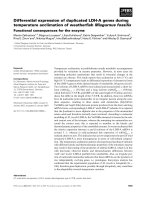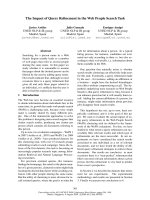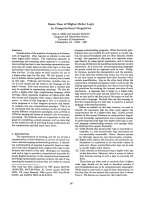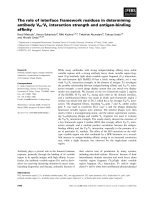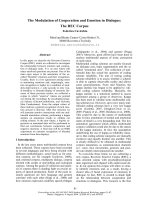Báo cáo khoa học: "THE EXPRESSION OF LOCAL RHETORICAL RELATIONS IN INSTRUCTIONAL TEXT*" pdf
Bạn đang xem bản rút gọn của tài liệu. Xem và tải ngay bản đầy đủ của tài liệu tại đây (288.62 KB, 3 trang )
THE EXPRESSION OF LOCAL RHETORICAL RELATIONS IN
INSTRUCTIONAL TEXT*
Keith Vander Linden
Department of Computer Science
University of Colorado
Boulder, CO 80309-0430
Internet:
INTRODUCTION
Given the prevalence of the use of rhetorical rela-
tions in the generation of text (Itovy, 1989; Moore
and Paris, 1988; Scott and Souza, 1990), it is
surprising how little work has actually been done
on the grammatical realization of these relations.
Most systems, based on Mann and Thompson's
formulation of Rhetorical Structure Theory (Mann
and Thompson, 1988), have adopted simplified so-
lutions to their expression. If, for example, an ac-
tion, X, and a purpose for that action, Y, must be
expressed, a standard form such as "Do X in or-
der to Y" will be generated. In reality, the purpose
relation can be and is expressed in a myriad of dif-
ferent ways depending upon numerous functional
considerations. Consider the following examples:
(la) Follow the steps in the illustration below,
for desk installation. (code 1)
(lb) To install the phone on a desk, follow the
steps in the illustration below.
(le) Follow the steps in the illustration below,
for installing the phone on a desk.
(ld) For the desk, follow the steps in the
illustration below.
These examples of purpose expressions illus-
trate two issues of choice at the rhetorical level.
First, the purpose clauses/phrases can occur ei-
ther before or after the actions which they moti-
vate. Second, there are four grammatical forms to
choose from (all found in our corpus). In (la), we
see a "for" prepositional phrase with a nominaliza-
tion ("installation") as the complement, in (lb), a
"to" infinitive form (tnf), in (lc), a "for" preposi-
tion with a gerund phrase as a complement, and
*This work was supported in part by NSF Grant
IRI-9109859.
1 My convention will be to add a reference to the end
of all examples that have come from our corpus, indi-
cating which manual they came from. (code) and (exc)
will stand for examples from the Code-a-Phone and
Excursion manuals respectively (Code-a-phone, 1989;
Excursion, 1989). All other examples are contrived.
318
in (ld), a "for" preposition with a simple object
as the complement. Although all these forms are
grammatical and communicate the same basic in-
formation, the form in (la) was used in the corpus.
I am interested in the functional reasons for this
choice.
Another aspect of this analysis to notice is
that, contrary to the way rhetorical structure the-
ory has been used in the past, I have allowed
phrases, as well as clauses, to enter into rhetor-
ical relations. This enables me to address the use
of phrases, such as those in (la), (lc), and (ld),
which hold rhetorical relations with other spans of
text.
The proper treatment of alternations such as
these is crucial in the generation of understandable
text. In the following sections, I will discuss a
methodology for identifying such alternations and
include samples of those I have found in a corpus
of instructional text. I will then discuss how to
formalize and implement them.
IDENTIFYING
ALTERNATIONS
I identified alternations by studying the linguistic
forms taken on by various rhetorical relations in a
corpus of instructional text. The corpus, currently
around 1700 words of procedural text from two
cordless telephone manuals, was large enough to
expose consistent patterns of instructional writing.
I plan to expand the corpus, but at this point, the
extent to which my observations are valid for other
types of instructions is unclear.
To manage this corpus, a text database sys-
tem was developed which employs three inter-
connected tables: the clause table, which repre-
sents all the relevant information concerning each
clause (tense, aspect, etc.), the argument table,
which represents all the relevant information con-
cerning each argument to each clause (subjects,
objects, etc.), and the rhetorical relation table,
which represents all the rhetorical relations be-
tween text spans using Mann and Thompson's for-
malism. I used this tool to retrieve all the clauses
and phrases in the corpus that encode a particular
local rhetorical relation. I then hypothesized func-
tional reasons for alternations in form and tested
them with the data. I considered a hypothesis
successful if it correctly predicted the form of a
high percentage of the examples in the corpus and
was based on a functional distinction that could
be derived from the generation environment 2.
I have analyzed a number of local rhetorical
relations and have identified regularities in their
expression. We will now look at some representa-
tive examples of these alternations which illustrate
the various contextual factors that affect the form
of expression of rhetorical relations. A full anal-
ysis of these examples and a presentation of the
statistical evidence for each result can be found in
Vander Linden (1992a).
PURPOSES
One important factor in the choice of form is the
availability of the lexicogrammatical tools from
which to build the various forms. The purpose re-
lation, for example, is expressed whenever possible
as a "for" prepositional phrase with a nominaliza-
tion as the complement. This can only be done,
however, if a nominalization exists for the action
being expressed. Consider the following examples
from the corpus:
(2a) Follow the steps in the illustration below,
for desk installation.
(code)
(2b) End the second call, and tap FLASH
to
return to the first call
(code)
(2e) The OFF position is primarily used
for
charging the batteries.
(code)
Example (2a) is a typical purpose clause
stated as a "for" prepositional phrase. Example
(2b) would have been expressed as a prepositional
phrase had a nominalization for "return" been
available. Because of this lexicogrammatical gap
in English, a "to" infinitive form is used. There
are reasons that a nominalization will not be used
even if it exists, one of which is shown in (2e).
Here, the action is not the only action required
to accomplish the purpose, so an "-ing" gerund is
used. This preference for the use of less prominent
grammatical forms (in this case, phrases rather
2In the process of hypothesis generation, I have
frequently made informal psycholinguistic tests such
as judging how "natural" alternate forms seem in the
context in which a particular form was used, and have
gone so far as to document this process in more com-
plete discussions of this work (Vander Linden et al.,
1992a), but these tests do not constitute the basis of
my criteria for a successful hypothesis.
than clauses) marks the purposes as less impor-
tant than the actions themselves and is common
in instructions and elsewhere (Cumming, 1991).
PRECONDITIONS
Another issue that affects form is the textual con-
text. Preconditions, for example, change form de-
pending upon whether or not the action the pre-
condition refers to has been previously discussed.
Consider the following examples:
(3a)
When you hear dial tone,
dial the number
on the Dialpad [4].
(code)
(3b)
When the 7010 is installed
and the battery
has charged for twelve hours, move the
OFF/STBY/TALK
[8] switch to STBY. (code)
Preconditions typically are expressed as in
(3a), in present tense as material actions. If,
however, they are repeat mentions of actions pre-
scribed earlier in the text, as is the case in (3b),
they are expressed in present tense as conditions
that exist upon completion of the action. I call
this the
terminating condition
form. In this case,
the use of this form marks the fact that the readers
don't have to redo the action.
RESULTS
Obviously, the content of process being described
affects the form of expression. Consider the fol-
lowing examples:
(4a) When the 7010 is installed and the battery
has charged for twelve hours, move the
OFF/STBY/TALK [8] switch to STBY.
The
7010 is now ready to use.
(code)
(4b) 3. Place the handset in the base.
The
BATTERY CHARGE INDICATOR will light.
(exc)
Here, the agent that performs the action de-
termines, in part, the form of the expression. In
(4a), the action is being performed by the reader
which leads to the use of a present tense, relational
clause. In (4b), on the other hand, the action is
performed by the device itself which leads to the
use of a future tense, action clause. This use of fu-
ture tense reflects the fact that the action is some-
thing that the reader isn't expected to perform.
CLAUSE COMBINING
User modeling factors affect the expression of in-
structions, including the way clauses are com-
bined. In the following examples we see actions
being combined and ordered in different ways:
(5a) Remove the handset from the base and lay
it on its side. (exc)
319
(5b) Listen for dial tone, then make your next
call (code)
(5c) Return the OFF/STBY/TALK switch to
STBY after your call. (code)
Two sequential actions are typically expressed
as separate clauses conjoined with "and" as in
(5a), or, if they could possibly be performed si-
multaneously, with "then" as in (5b). If, on the
other hand, one of the actions is considered obvi-
ous to the reader, it will be rhetorically demoted
as in (5c), that is stated in precondition form as
a phrase following the next action. The manual
writer, in this example, is emphasizing the actions
peculiar to the cordless phone and paying rela-
tively little attention to the general skills involved
in using a standard telephone, of which making a
call is one.
IMPLEMENTING
ALTERNATIONS
This analysis of local rhetorical relations has re-
sulted in a set of interrelated alternations, such
as those just discussed, which I have formalized in
terms of system networks from systemic-functional
grammar (Halliday, 1976) 3.
I am currently implementing these networks
as an extension to the Penman text generation ar-
chitecture (Mann, 1985), using the existing Pen-
man system network tools. My system, called
IMAGENE,
takes a non-linguistic process structure
such as that produced by a typical planner and
uses the networks just discussed to determine the
form of the rhetorical relations based on functional
factors. It then uses the existing Penman networks
for lower level clause'generation.
IMAGENE
starts by building a structure based
on the actions in the process structure that are to
be expressed and then passes over it a number of
times making changes as dictated by the system
networks for rhetorical structure. These changes,
including various rhetorical demotions, marking
nodes with their appropriate forms, ordering of
clauses/phrases, and clause combining, are im-
plemented as systemic-type realization statements
for text. IMAGENE finally traverses the completed
structure, calling Penman once for each group of
nodes that constitute a sentence. A detailed dis-
cussion of this design can be found in Vander Lin-
den (1992b). IMAGENE is capable, consequently,
of producing instructional text that conforms to
a formal, corpus-based notion of how realistic in-
structional text is constructed.
3System networks are decision structures in
the
form of directed acyclic graphs, where each decision
point represents a system that addresses
one of the
alternations.
320
REFERENCES
Code-a-phone (1989). Code-A-Phone Owner's
Guide. Code-A-Phone Corporation, P.O. Box
5678, Portland, OR 97228.
Cumming, Susanna (1991). Nominalization in
English and the organization of grammars.
In Proceedings of the IJCAI-91 Workshop on
Decision Making Throughout the Generation
Process, August 24-25, Darling Harbor, Syd-
ney, Australia.
Excursion (1989). Excursion 8100. Northwestern
Bell Phones, A USWest Company.
Halliday, M. A. K. (1976). System and Function in
Language. Oxford University Press, London.
Ed. G. R. Kress.
Hovy, Eduard H. (1989). Approaches to the
planning of coherent text. Technical Report
ISI]RR-89-245, USC Information Sciences In-
stitute.
Mann, William C. (1985). An introduction to
the Nigel text generation grammar. In Ben-
son, James D., Freedle, Roy O., and Greaves,
William S., editors, Systemic Perspectives on
Discourse, volume 1, pages 84-95. Ablex.
Mann, William C. and Thompson, Sandra A.
(1988). Rhetorical structure theory: A the-
ory of text organization. In Polanyi, Livia,
editor, The Structure of Discourse. Ablex.
Moore, Johanna D. and Paris, Cdcile L. (1988).
Constructing coherent text using rhetorical
relations. Submitted to the Tenth Annual
Conference of the Cognitive Science Society,
August 17-19, Montreal, Quebec.
Scott, Donia R. and Souza, Clarisse Sieckenius de
(1990). Getting the message across in RST-
based text generation. In Dale, Robert, Mel-
lish, Chris, and Zock, Michael, editors, Cur-
rent Research in Natural Language Genera-
lion, chapter 3. Academic Press.
Vander Linden, Keith, Cumming, Susanna, and
Martin, James (1992a). The expression of lo-
cal rhetorical relations in instructional text.
Technical Report CU-CS-585-92, the Univer-
sity of Colorado.
Vander Linden, Keith, Cumming, Susanna, and
Martin, James (1992b). Using system net-
works to build rhetorical structures. In Dale,
R., Hovy, E., RSesner, D., and Stock, O., edi-
tors, Aspects of Automated Natural Language
Generation. Springer Verlag.

